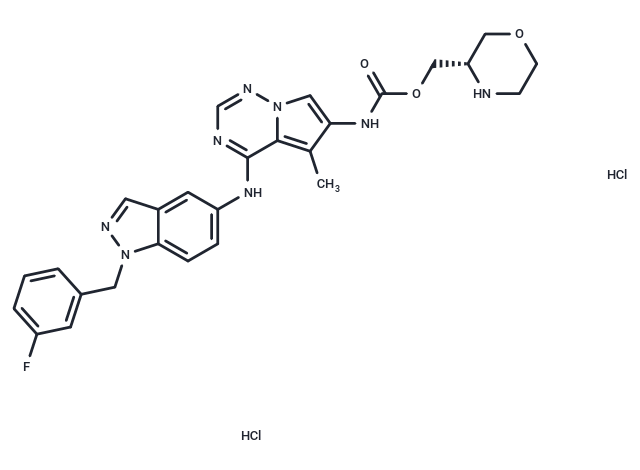 您的购物车当前为空
您的购物车当前为空
BMS 599626 2HCl
一键复制产品信息别名 AC480 dihydrochloride
BMS 599626 2HCl (873837-23-1(HCl)) (AC480 dihydrochloride) 是 HER1 和 HER2 的选择性抑制剂(IC50:20 nM 和 30 nM),对 HER4 的效力降低约 8 倍,对 Lck、VEGFR2、c-Kit、MET 等的效力降低 100 倍以上。

BMS 599626 2HCl
一键复制产品信息BMS 599626 2HCl (873837-23-1(HCl)) (AC480 dihydrochloride) 是 HER1 和 HER2 的选择性抑制剂(IC50:20 nM 和 30 nM),对 HER4 的效力降低约 8 倍,对 Lck、VEGFR2、c-Kit、MET 等的效力降低 100 倍以上。
| 规格 | 价格 | 库存 | 数量 |
|---|---|---|---|
| 1 mg | ¥ 336 | 待询 | |
| 5 mg | ¥ 1,090 | 待询 | |
| 10 mg | ¥ 1,750 | 待询 | |
| 25 mg | ¥ 3,650 | 待询 | |
| 50 mg | ¥ 5,270 | 待询 | |
| 100 mg | ¥ 7,430 | 待询 | |
| 1 mL x 10 mM (in DMSO) | ¥ 2,780 | 现货 |
BMS 599626 2HCl 相关产品
产品介绍
| 产品描述 | BMS 599626 2HCl (873837-23-1(HCl)) (AC480 dihydrochloride) is a selective inhibitor of HER1 and HER2 (IC50s: 20 nM and 30 nM), ~8-fold less potent to HER4, >100-fold to Lck, VEGFR2, c-Kit, MET, etc. |
| 靶点活性 | HER3:190 nM (cell free), HER2:30 nM (cell free), HER1:20 nM (cell free) |
| 体外活性 | BMS-599626在抑制HER1和HER2活性方面展现出了显著效果,IC50分别为20和30 nmol/L,并且在针对广泛多样蛋白激酶的测试中显示出高度选择性。该化合物能够有效中断HER1和HER2的信号传导,并抑制依赖这些受体的肿瘤细胞系的增殖,IC50范围在0.24到1 micromol/L之间。BMS-599626对依赖HER1/HER2的肿瘤细胞具有高度选择性,并且对不表达这些受体的细胞系的增殖无影响。在能够形成HER1/HER2异二聚体的肿瘤细胞中,BMS-599626抑制了异二聚体形成及其下游信号传导[1]。在10 μM浓度下,BMS-599626对控制组A2780肿瘤细胞未显示出显著的非靶向效应[2]。在HN-5细胞中,BMS-599626抑制了pEGFR、pHER2、cyclins D和E、pRb、pAkt、pMAPK、pCDK1和2、CDK 6以及Ku70蛋白的表达,并导致细胞在G1周期阶段的积累、抑制了细胞生长,并增强了放射敏感性[3]。 |
| 体内活性 | 在60 mg/kg的剂量下,BMS-599626显著延缓了治疗过程中的肿瘤生长,但一旦停止治疗,肿瘤生长即恢复。更高剂量的BMS-599626能够更持久地抑制肿瘤生长,但所有情况下,停止治疗后肿瘤生长仍会恢复。在每日一次给药方案中,连续给药14天,BMS-599626的最大耐受剂量为240 mg/kg [1]。 |
| 激酶实验 | The entire cytoplasmic sequences of HER1, HER2, and HER4 were expressed as recombinant proteins in Sf9 insect cells. HER1 and HER4 were expressed as fusion proteins with glutathione-S-transferase and were purified by affinity chromatography on glutathione-S-Sepharose. HER2 was subcloned into the pBlueBac4 vector and expressed as an untagged protein using an internal methionine codon for translation initiation. The truncated HER2 protein was isolated by chromatography on a column of DEAE-Sepharose equilibrated in a buffer that contained 0.1 mol/L NaCl, and the recombinant protein was eluted with a buffer containing 0.3 mol/L NaCl. For the HER kinase assays, reaction volumes were 50 μL and contained 10 ng of glutathione-S-transferase fusion protein or 150 ng of partially purified HER2. The mixtures also contained 1.5 μmol/L poly(Glu/Tyr) (4:1), 1 μmol/L ATP, 0.15 μCi [γ-33P]ATP, 50 mmol/L Tris-HCl (pH 7.7), 2 mmol/L DTT, 0.1 mg/mL bovine serum albumin, and 10 mmol/L MnCl2. Reactions were allowed to proceed at 27°C for 1 hour and were terminated by the addition of 10 μL of a stop buffer (2.5 mg/mL bovine serum albumin and 0.3 mol/L EDTA), followed by a 108-μL mixture of 3.5 mmol/L ATP and 5% trichloroacetic acid. Acid-insoluble proteins were recovered on GF/C Unifilter plates with a Filtermate harvester. Incorporation of radioactive phosphate into the poly(Glu/Tyr) substrate was determined by liquid scintillation counting. Percent inhibition of kinase activity was determined by nonlinear regression analyses and data were reported as the inhibitory concentration required to achieve 50% inhibition relative to control reactions (IC50). Data are the averages of triplicate determinations. All other tyrosine kinases were also assayed using poly(Glu/Tyr) as a substrate [1]. |
| 细胞实验 | All cell lines were maintained in RPMI 1640 supplemented with 10% fetal bovine serum, 100 units/mL penicillin, and 100 μg/mL streptomycin. Cells were plated at 1,000 per well in 96-well plates and were cultured for 24 hours before test compounds were added. Compounds were diluted in culture medium such that the final concentration of DMSO never exceeded 1%. Following the addition of compounds, the cells were cultured for an additional 72 hours before cell viability was determined by measuring the conversion of 3-(4,5-dimethylthiazol-2-yl)-2,5-diphenyltetrazolium bromide dye with the CellTiter96 kit. For some cell lines, there was a lack of a correlation between 3-(4,5-dimethylthiazol-2-yl)-2,5-diphenyltetrazolium bromide dye metabolism and cell number, and a thymidine uptake assay was used to measure proliferation of these cell lines. Cells were plated in 96-well plates and treated with compounds as above. At the end of the 72-hour incubation, cells were pulsed with [3H]thymidine (0.4 μCi/well) for 3 hours before they were harvested. Cells were digested with 2.5% trypsin for 10 minutes at 37°C and were harvested by filtration using a Packard Filtermate Harvester and GF/C Unifilter plates. Incorporation of radioactive thymidine into nucleic acids was determined by liquid scintillation counting [1]. |
| 动物实验 | The following murine and human tumor models were employed in the evaluation of BMS-599626: SAL2 murine salivary gland tumor, N87 human gastric carcinoma, BT474 human breast tumor, A549 human non–small-cell lung tumor, and GEO human colon tumor. All tumors were maintained and passaged in athymic female nude mice (nu/nu, HSD). Tumors were propagated as s.c. transplants using tumor fragments obtained from donor mice. For oral administration to mice, BMS-599626 was dissolved in a mixture of propylene glycol/water (50:50). The volume of all compounds administered was 0.01 mL/g body weight. Each nude mouse was given a s.c. implant of a tumor fragment (~20 mg) with a 13-gauge trocar. Tumors were allowed to grow to ~100 to 200 mm3 and animals were evenly distributed to various treatment and control groups of eight mice each. Tumor response was determined by measurement of tumors with a caliper twice a week until the tumors reached a predetermined "target" size of 0.5 to 1.0 g. Tumor weights (mg) were estimated from the following formula: tumor weight = (length × width2) / 2 [1]. |
| 别名 | AC480 dihydrochloride |
| 分子量 | 603.48 |
| 分子式 | C27H29FN8O3Cl2 |
| CAS No. | 1781932-33-9 |
| Smiles | O=C(OC[C@@H]1COCCN1)NC2=CN3C(C(NC4=CC=C(N(N=C5)CC6=CC(F)=CC=C6)C5=C4)=NC=N3)=C2C.Cl.Cl |
| 密度 | no data available |
| 存储 | Powder: -20°C for 3 years | In solvent: -80°C for 1 year | Shipping with blue ice/Shipping at ambient temperature. | ||||||||||||||||||||||||||||||||||||||||
| 溶解度信息 | DMSO: 95 mg/mL (157.42 mM), Sonication is recommended. H2O: 3 mg/mL (4.97 mM), Sonication is recommended. | ||||||||||||||||||||||||||||||||||||||||
溶液配制表 | |||||||||||||||||||||||||||||||||||||||||
H2O/DMSO
DMSO
| |||||||||||||||||||||||||||||||||||||||||




 很棒
很棒

 |
|
评论内容